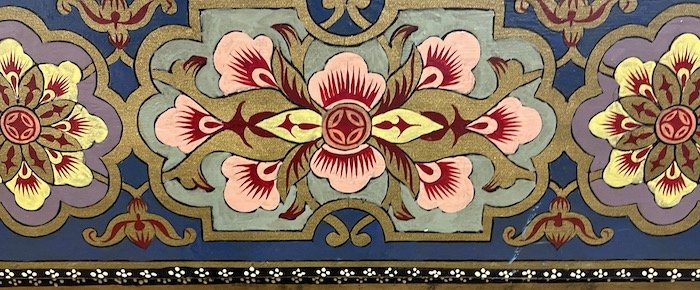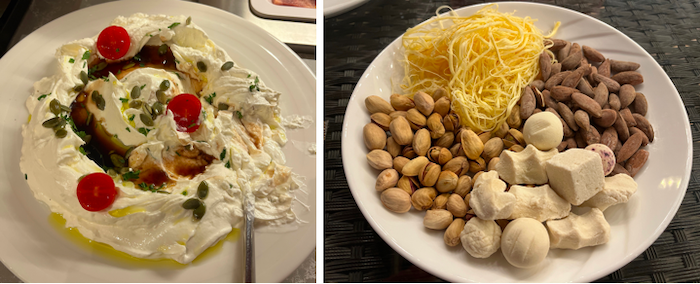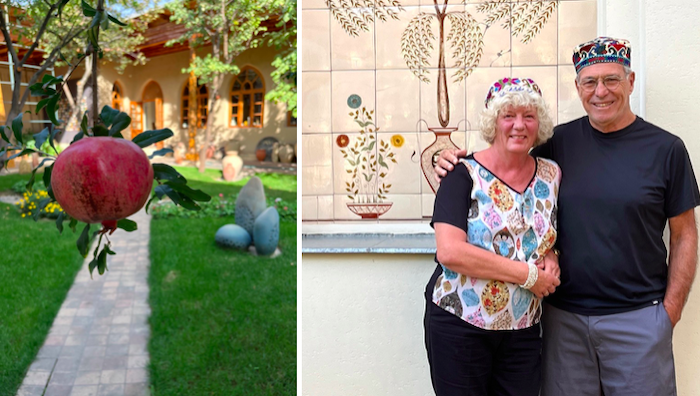I heard a bump in the night. Actually, more of a thud followed by a few choice swear words. Michael missed the last step of the curved stairway in our Airbnb in Samois-sur-Seine and landed in a heap.
The reason Mr. Campbell was tiptoeing around at 5:00 am was to watch the Seahawk’s first game of the season - and he didn’t want to wake me. Obviously, that plan didn’t work. Once we got him upright, he couldn't put weight on his left foot, and it began to swell immediately.
This happened one week before we were to leave France for our much-anticipated trip to "The Stans." Michael convinced himself it wasn’t too bad - lots of ice and keeping it elevated would fix things in a day or two, right? So off we went, even though walking was painful and his foot was still visibly bruised and puffy.
We arrived in Tashkent, and since Michael could get around, we carried on with our itinerary. After three days, we took a side trip to Dushanbe, Tajikistan, where our tour guide had us walk nine miles around the city. Michael’s foot did not take kindly to this abuse and let him know it.
A nine-mile trek through Dushanbe, Tajikistan was hard on Michael’s foot - but worth the walk.
When we returned to Tashkent to continue our travels in Uzbekistan, it was time to see a doctor. Our tour organizer and now good friend Mikhail jumped into action. He got us into a clinic for an X-ray and a visit with an orthopedic doctor within hours of arriving.
The facility was new, the process very efficient, and we paid around $27.00 for everything! Once Michael’s foot had been X-rayed, we went upstairs to knock on one of many simple wooden doors along a hallway, and the doctor himself opened the door to his small office. I took one look and let out an involuntary guffaw - the doctor looked just like Waldorf of Stadler and Waldorf, Michael’s favorite Muppet characters.
From that moment, it was hard to get Michael to take the man seriously, but I gave him stern looks and signaled he should pay attention. Luckily the doctor didn’t speak English so didn’t know why we both kept chortling.
In the end, he confirmed what we already suspected, Michael had fractured a toe and probably mangled a few tendons. There wasn’t much to be done other than take Extra Strength Tylenol, wear double socks on that foot, and elevate it whenever possible.
Yes, the doctor looks a lot like Waldorf … but Michael bears a vague resemblance to Statler!
Doctor’s orders?
For our return visit to Tashkent, we booked an Airbnb, but after our dismal experience in Dushanbe, Tajikistan, we were a little gun-shy. Are all Airbnb listings in this part of the world destined to be two-star listings? This one seemed okay from the pictures, but anything would be an upgrade from our previous experience.
As we pulled up to the building, we could see it was definitely a part of a large housing estate - not in terrible condition, but indeed a 70s-era Soviet structure. We were met by Rasul, a friend of our host who only spoke Russian. We took an actual working elevator to the 5th floor and opened the front door. We held our breath and It turned out to be...wonderful! The decor was definitely “different," but it was spacious and full of natural light. The kitchen was modern and well-equipped, and the Queen Size bed was very comfortable! Our shoulders dropped considerably, and we settled in.
The view from the kitchen window was interesting any time of day, but the sunsets were amazing.
We were delivered to our Airbnb by our new friend Ilhom Miliyer. He is the representative for the Seattle / Tashkent Sister City program. Here is how Wikipedia describes a Sister-City relationship. “A sister city, county, or state relationship is a broad-based, long-term partnership between two communities in two countries. The relationship is officially recognized after both communities' highest elected or appointed officials sign a reciprocal agreement.”
In 2021, when Michael began researching our trip to Uzbekistan, he vaguely remembered we had this relationship and found a link on the City of Seattle website. He dug a little deeper, and found a local contact. He inquired if connecting with someone on the ground in Tashkent was possible? An hour later, he received a email from Mr. Shakhida Ismailova, who introduced him to Ilhom. Within 24 hours, we’d made a new friend on the other side of the world who kindly offered to pick us up at the airport. Amazing!
Seattle has 20 Sister Cities worldwide, but there is an interesting back story with Tashkent. The relationship was formed in 1973 when Uzbekistan was part of the USSR. This was the first time a Soviet and a US City began a Sister City relationship. One of the most important legacies of this program was the teacher exchanges between the two cities. Many of the students and their teachers from both countries are still in contact today. Ilhom’s wife participated in a number of teacher exchanges and his daughter moved to Seattle to attend university. She lived all four years with Dan Peterson, one of the founding members of the program, and his family.
Enjoying tea at Human House with Ilhom surrounded by historical images of the creation of Friendship Park ,also known as Seattle-Tashkent Peace Park. The “Mug shots” are of local volunteers. Learning about this relationship cemented our friendship with Ilhom and our love of Tashkent.
In 1988 a contingent from Seattle went to Tashkent to work with local citizens to create a memorial park in the city's center called Friendship Park (or Seattle-Tashkent Peace Park). Ilhom took us to a small museum in a facility called Human House, where there were historical documents along with photos, and illustrations of the park’s construction. Part of the park’s charm includes hundreds of hand-painted tiles brought by the Seattle delegation or painted by local volunteers in Tashkent.
A photo of volunteers from Seattle at the newly constructed park taken in 1988.
Just some of the hundreds of hand-painted tiles that decorate the Sister City monument in Tashkent.
Over time, the park has been encroached on by new construction. Now only portions of the tile walls and a few statues remain. But there is still a spirit of cooperation between the two cities. In fact, there will be a celebration of 40 years of friendship next year - and the park will be refurbished by volunteers. Michael and I will attend the Seattle Chapter Annual Meeting in Seattle in December.
With our guide Helen in the garden of the Rakhimov Ceramic Studio.
We had a new tour guide on our second to last day in Tashkent. Her name was Helen, and she was excellent company. She was sporting a Formula 1 tee shirt, so she and Michael quickly bonded over car racing.
Early on April 26, 1966 a devastating earthquake leveled large parts of the city and Helen started our tour at a Soviet-style memorial commemorating that day. Since then, the city has been doing its best to create a beautiful “new metropolis” with earthquake safety top-of-mind.
We took the metro to a few stops to see some Moscow-inspired stations. If you’ve ever experienced the Moscow metro, you know how stunning the architecture is. Tashkent’s stations are not at that level - but its creation in 1968 made it the first subway system in Central Asia.
Michael and Helen having a good political discussion while we visited the metro stations.
We visited the Minor Mosque, which is anything but minor (that is the name of the neighborhood). It is a massive, white marble-clad building that practically shimmers in the heat. It is sleek and lavish at the same time - and has a dome that dominates. Built in 2014 by an Uzbek Oligarch (who is on the US sanctions list), it was a gift to the people of Tashkent. Mainly for the men of Tashkent. This mighty mosque, which can hold 2,400 worshipers on holy Friday, offers a segregated prayer room for women the size of a cheap motel room. It even has a gate (albeit a beautiful one) so that no female accidentally wanders onto the carpet of the cavernous male-only prayer room.
Nothing was minor about this Minor Mosque!
If there was one thing that got on my nerves while we were here, it was the overbearing male presence. Men were everywhere, and women were not (mainly because they were working). Men could be found lounging about all over the place. The situation seems more annoying than oppressive here, and most young women do not cover themselves - at least in Tashkent. But you could feel the vibe.
On this second visit we were able to try another national dish. When we first arrived, we had a traditional Plov lunch. This time we enjoyed Lagman, a rich, spicy noodle soup from the Uyghur region. Each Lagman noodle is about 3 feet long, so gathering a bite on your fork (even with help from a spoon) can be tricky.
Michael digging in to his bowl full of very long lagman noodles. It was delicious.
Speaking of food. Beyond Plov and Lagman, we tried two other intriguing foods. Suzma (which I loved) a thick sour cream that was served with balsamic, tomatoes, and oregano, and snacks that were both strange and delicious. Hard soured cheese balls that were to be nibbled, amazing pistachios and almonds, and an addictive dry, smoked string cheese that comes in a tight braid to unravel.
We rode up to the observation level of the famous TV Tower, which was a bit of a yawn. But our final stop was one of the highlights of our stay in Tashkent. We spent at least an hour at the home and ceramics studio of the Rakhimov family, where they have been creating elegant pottery for over four generations.
Their home was a traditional Uzbek home with a large open courtyard surrounded by two stories of family living quarters, two large studios, a kiln room, and a gallery. In the central garden, Ruby red pomegranates and fragrant oranges weighed down tree branches, and captivating ceramic animals nestled in the flower beds. The open-air studio was full of stunning vases, pots, and plates in all stages of production. Pieces of ancient pottery strewn around the tables provided inspiration for new works. And entire walls were covered with small disks that functioned as “sketches” for upcoming projects.
We met Alisher and his father. Both were master craftsmen and gentle men. We also heard about but did not meet his four-year-old grandson who lives with him. In their family, it is a tradition that when a boy turns four years old, he moves in with his grandfather to learn the pottery trade along with some very sound life lessons.
I wish we could have purchased something wonderful from this visit but without a home….
Another way the Rakhimov family extends their ceramic legacy is to teach. They accept around 20 children a year, ages 6 and 12, to participate in an extensive two-week workshop. From those, a handful is selected to become apprentices. The reason for the 12-year age limit is their belief that once a child reaches that age, their unfettered imaginations give way to the discipline of schoolwork and other influences that “snuff out” creativity!
On our final night we attended an excellent classical music concert and being out in the city at night was simply magical. Intricate panels of colored lights blaze over most avenues, and many ancient and state-of-the-art buildings are dramatically lit.
Finally it was time to say goodbye to Mikhail and thank him for all of his kindness. We invited him and a friend to lunch where I did my best with local ingredients to prepare an All America lunch. We had juicy cheeseburgers, pasta salad and watermelon. The only surprise was when I cut into the melon it was bright yellow inside!
Tashkent is often regarded as a necessary stepping stone to the more seductive cities of the Silk Road - Samarkand, Bukhara, and Khiva. But you'll find a few days in this fascinating capital city worth your time.
See you in Samarkand.
Thanks for following along,
Debbie and Michael Campbell
The Senior Nomads
























